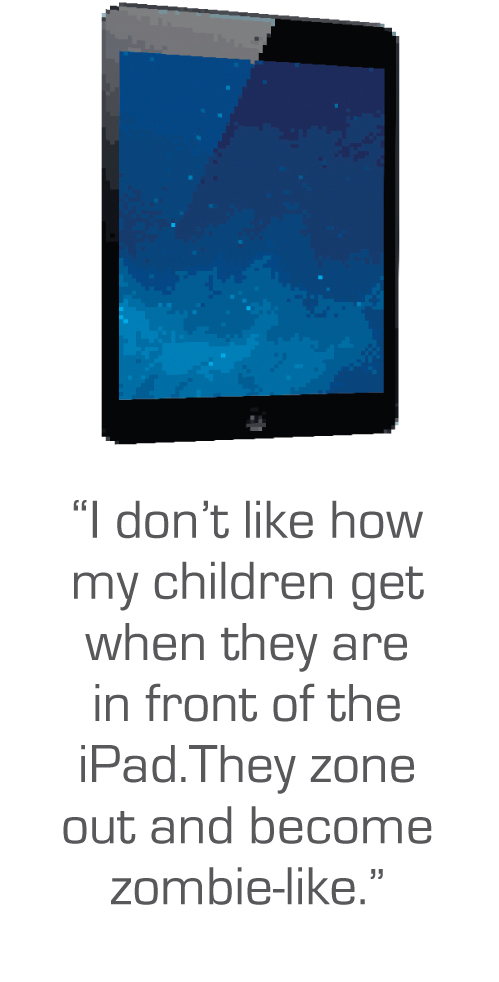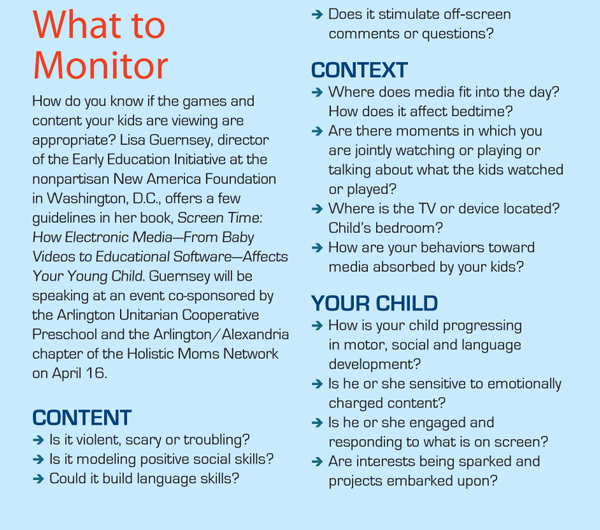

CHILD PSYCHOLOGIST Steve Harner has treated many kids for anxiety during his 20 years in practice. But lately he has noticed a new kind of trigger, which he describes with this hypothetical scenario: A 9-year-old boy suddenly develops a spate of fears that lead to insomnia and a need for constant reassurance from his parents. As his worries escalate, the boy begins having panic attacks on the way to school because he’s afraid of dying in a car accident. It’s soon discovered that the boy and his older siblings have been playing Grand Theft Auto, a video game known for its high-speed car chases and graphic violence. Unsure of what to do, the parents land in Harner’s Falls Church office in crisis mode, seeking help in putting some controls on screen time at home.
While this may be an extreme example, Harner says that technology-fueled angst is becoming more commonplace in kids. It’s often accompanied by increased irritability, disconnection from peers, obsessive talk about video games and even neck and joint pain.
“Young kids have a hard time differentiating fantasy from reality,” he says. “We encourage parents to deal with the immediate problem and also take a step back and work on preemption before it becomes a [bigger] problem.”
FOR THOSE OF US who grew up in an analog era (save the occasional visit to the arcade to play games like Space Invaders and Pac-Man), this is largely uncharted territory. Today’s kids have unprecedented access to screens of all kinds, and they can get their game on almost anywhere.
Moreover, they’re starting young. According to research by Common Sense Media, a San Francisco-based education advocacy nonprofit, the number of children ages 8 and under who are using some type of mobile media device (including smartphones, tablets and iPod touches) jumped from 38 percent in 2011 to 72 percent in 2013. And get this: The number of kids ages 2 and under using mobile devices nearly quadrupled in that same two-year period, from 10 percent to 38 percent.
Of course, most kids are emulating behaviors modeled by their parents. A quick snapshot of any elevator, Metro station or doctor’s office usually finds adults fiddling on their smartphones or reading their tablets. As one recent customer review for the Amazon Kindle Fire Kids Edition stated, “I bought this for my 5-year-old son so that he would stop playing on my phone.”
Still, parents expect their kids to do what they say and not what they do. And concerns over the possible ill effects of technology have prompted many to set limits on screen time.
As the owner of EverWonder, a day camp in Arlington, Moley Evans insists that her campers spend at least an hour outside every day—the so-called “green hour” that Richard Louv touted in his acclaimed 2005 book, Last Child in the Woods, about so-called “nature deficit disorder.”
Evans’ own kids (who are in third and fourth grade at Campbell Elementary) are allowed 20 minutes of screen time each on the weekends—a privilege she and her husband grant with some reluctance. “I don’t like how my children get when they are in front of the iPad,” says Evans, who lives in Alcova Heights. “They zone out and become zombie-like. But I don’t want to completely restrict it, because then it becomes something they really want even more.”
Further complicating matters is the fact that their third-grader now has an iPad at school, thanks to Arlington Public Schools’ (APS) Digital Learning Initiative, which aims to provide every student with a personalized device by 2017. The rationale, according to APS, is to leverage technology to prepare students for a rapidly changing world, equalize access to technology for all students and teach good digital citizenship.
It’s a move that has produced mixed feelings in parents like Evans. “I don’t think iPads are all bad,” she says, “but teachers, books and manipulatives [tactile learning devices, such as counters, dominoes or beads] should not be replaced with iPads. You can’t have a meaningful conversation with an iPad.”
You can, however, build a complex virtual world and learn spatial problem-solving in the video game Minecraft. Or create a short film of your summer vacation using Camtasia video-editing software. Or learn Spanish while streaming an episode of Dora the Explorer.
These are all things that have been hailed as positive outcomes of modern technology. How can parents separate the bad from the good?
WHEN IT COMES to screen time, the American Academy of Pediatrics recommends no television or other entertainment media for infants and children under age 2, and no more than two hours a day for older kids. But few parents seem to adhere to those guidelines.
Elizabeth Galentine, a Falls Church mother of three boys under 5, says she allows some screen time every day, including TV. “I have to admit it does help to keep them relatively still while I’m trying to clean up around the house,” she says, “but there is a pervasive feeling of mom guilt. Is it too much?”
Of course, digital consumption tends to increase as children get older. A 2010 Kaiser Family Foundation report found that kids between the ages of 8 and 18 watch more than 4 hours of TV per day. And that’s not including the staggering amount of time that tweens and teenagers spend on their mobile devices. The average teenager sends 3,364 texts per month, according to a 2011 Pew Research study of 13- to 17-year-olds.
This growing phenomenon has prompted much research into the potential physical and emotional side effects of electronic overload. Some researchers have pinpointed brain atrophy in people with a diagnosed Internet-based gaming addiction (characterized in one study as more than 10 hours per day, six days a week), with damage to both the gray matter (where processing occurs) and the white matter (which governs communication between functions and emotions).
A 2012 study published in the journal Experimental Brain Research found that children suffered measurable increases in motion sickness and postural problems after excessive video game play.
Pediatricians, meanwhile, have plenty of anecdotal concerns about the Xbox generation. “I do not think I’m exaggerating when I say increased personal technology may be one of the biggest causes of decline in mental and physical health in our times,” says Arlington resident Bethany Epstein, a pediatrician with Virginia Pediatric and Adolescent Center in Springfield. “Most of the teenagers I see have insomnia or disordered sleep because they have a screen in their face at all hours. Many kids are not learning playground politics because they don’t go outside. There is much less independent, creative play.”
That’s a problem, insofar as interpersonal interaction and eye contact are key to building emotional intelligence. In a recent UCLA study, researchers separated 105 sixth-graders into two groups and asked them to identify the emotions presented in nearly 50 images of faces. The first group then spent five days at an outdoor education camp with no access to electronics (but plenty of human interaction), while the other group continued on with their everyday routines—devices and all. When students from both groups were later asked to evaluate the same images again, the outdoor-campers reduced their rate of error by nearly double that of the other group. In short, they were better at reading people.

Jessica Claire Haney and her family make outside time a priority.
DIGITAL FIXATION HAS also been known to cause discord at home. Parents dread the battles that arise when their kids have a difficult time transitioning away from their devices and into other activities. Suddenly, family time becomes a bit less magical.
“Our children tend to be more fun to be with when they haven’t had so much screen time,” says Jessica Claire Haney, a mother of two in Arlington’s Claremont neighborhood (she’s also founder and editor of Mindful Healthy Life, a web-based resource for holistic parenting and family wellness).
“When the screens are turned off, my kids play more, they draw and they even get bored a little,” she says. “I think it’s important that they’re not entertained all the time. If you don’t have the experience of thinking through something and having the time to wonder about it, then your brain isn’t going down those neural pathways that promote creativity.”
Author Richard Louv also laments what he calls “the know-it-all state of mind,” where having any piece of information at our fingertips has made the world too “small and known,” reducing children’s capacity for imagination.
But gaming and surfing habits, once established, can be hard to break and can even be addictive, notes Washington Post columnist and parenting coach Meghan Leahy. “Gaming devices tap into the reward center of the brain, the same part of the brain that likes cocaine and chocolate and sex,” she says. “In the past, if you wanted to play Scrabble, you had to ask me to play and I would say yes or no, and you had to deal with that. Today, a child picks up a video game, and [it is] designed to keep calibrating to a kid’s level, enticing them to play again and again and again. Then they can’t transition out of it.”
On this point, Leahy doesn’t hesitate to put some of the onus on parents. She cites the aforementioned 2010 Kaiser Family Foundation survey, in which two-thirds of children and teenagers said their parents have “no rules” about screen time.
“Parents say, ‘If you can’t get off [the device], I’m going to take it away.’ That lays the responsibility on the child when it’s not developmentally appropriate,” Leahy says. “We’re giving them the technology and then blaming them when they can’t handle it. I’m constantly pushing the responsibility back onto the parent. It’s not the job of the technology, not the school, not the clubs. If the parents give it, they have to be ready to monitor it.”
But monitoring also means staying current, notes Bill, an Ashton Heights father of two elementary-age kids who declined to use his last name. And that’s no small task. He says he expects to give his kids their own phones in middle school, but worries about keeping pace with the latest apps, hacks and safety concerns. “They’ll need to have some practice with keeping certain stuff private,” he says.
“But it’s a couple of years away, and that’s too far ahead to plan with technology—I have no idea what’s going to be out there by then.”
Deciding where to draw the line on usage is also tricky, says Aurora Highlands resident Dorothy Rounds. Her boys, who are 13 and 8, have limited access to their devices during the week, with more leeway on the weekends. She’s experienced the downside of too much screen time (what she calls “Minecraft meltdowns”) when it’s time to shut off, and has seen how much the pressure to keep up with the technology has increased. But her older son, a student at Gunston Middle, has begun to view screen time as a vital form of social currency.
“Our middle schooler especially feels connected to his peers through technology,” Rounds says sympathetically. “When I was that age, I was on the phone with my friends all the time. Now it’s the same thing, but they’re texting.”
Recognizing that social dynamic, Rounds and her husband decided to give their older son a smartphone for Christmas.
Still, she worries about the precedent that’s been set. “When my oldest son was about 5, when we went to Barnes & Noble, he went straight for the Thomas train table,” she says. “When my youngest was that age, he went straight for the Nooks. I feel like these devices came with his bib and bottle. I worry that handing over all this technology is like giving kids a bunch of torches and saying ‘Don’t start a fire.’ ”
FOR EVERY ALARMING story about the perils of technology, there are others that are encouraging. On a recent morning, Jamestown Elementary School Principal Kenwyn Schaffner and her second-grade teaching team are gathered in a circle with their iPads, going through digital lesson plans and learning new apps. Jamestown is at the vanguard of APS’s Digital Learning Initiative, with savvy teachers who are eager to reassure parents that screen time needn’t be wasted time.
“This isn’t just passive consumption of information,” Schaffner says. “We are using the iPads for higher-order thinking skills. Students can analyze and synthesize information using this technology, and then use it to create something new.”
As an example, the teachers describe an app that allows kids to write and produce their own stories, packaged as e-books, which are then accessible in an online library to all their classmates, equating their work with “real” books found in the library or bookstore.
Second-grade teacher Chidi Uche says that one of her students voluntarily took his school iPad with him on a family trip to India. Upon his return, he shared a movie that he had produced to document his travels, which included videos with spoken Hindi and images of the Taj Mahal. “I couldn’t have asked for a better lesson for my students,” Uche says.
Schaffner is quick to note a distinction between consuming and creating with the latest electronics. “We’re not just handing them the iPads and walking away,” she says. With guidance, the technology can be used in a productive way.
Even the Montessori School of McLean, which traditionally resisted technology-based learning, has recently incorporated laptop computers into its curriculum. Academic director Meredith Wood says the school has based much of its current thinking on Catherine Steiner-Adair’s book The Big Disconnect, which seeks to balance the benefits of technology while reducing the potential risks.
“Since [educator and founder Maria] Montessori said that education should be preparation for life, and technology is here to stay…it is our responsibility to teach children how to use it responsibly,” Wood says. “Children need to see the value of technology as a tool for their work, not just as mere entertainment. Providing them with the opportunity to work with technology appropriately allows them to work on finding the balance.”
Not all video games turn kids into zombies, either. Rene Hackney, a parent coach and founder of Parenting Playgroups in Alexandria, points to positive apps and games made by companies such as Handwriting Without Tears and Multiplication.com as useful for child development.
Rosetta Stone, the language company headquartered in Arlington, recently unveiled a digital program and app aimed at 3- to 7-year-olds, which teaches language with colorful characters. The company’s chief product officer, Nick Macey, says the design was influenced by research about the positive and negative aspects of screen time.
“We as a company believe in developing products that effectively use technology, are engaging and give children control with the right scaffolding,” Macey says. “For my own daughter, it’s important that she learn about technology and with technology, because it’s going to be a core component of her life.”
Even Minecraft, which now counts more than 18 million users worldwide, has been lauded for its positive influence on kids’ brains. In the game, players must use resources strategically to build in 3-D. The game’s maker, Mojang, was purchased by Microsoft in September for $2.5 billion.
“Minecraft is different,” tech writer Harry McCracken wrote in a 2013 Time magazine article. “The deeper you get into it, the more it looks like a form of self-education masquerading as entertainment, which is why parents tend not to see it as a scourge and teachers are bringing it into the classroom.”
But as with anything in life, moderation is advised. Harner, the Falls Church child psychologist, encourages parents to work with their kids to develop a weekly schedule that stresses routine and builds in screen time in metered doses.
“I always say that you are your kids’ best expert, but they are also experts on you,” he says, “so you have to be consistent when they push your buttons. I encourage parents to write down the family routine on a poster board or draw up a ‘use agreement’ so everything’s clear. This diffuses arguments and reduces the kids’ anxiety that they’ll never have screen time again.”
Equally important is scheduling off-line time to engage as a family. “I watched a ton of TV as a kid—soap operas, Three’s Company, you name it—and I regret all those lost hours,” says Haney, the Claremont mom. “So I consider every hour that goes by where my son isn’t watching a screen a small success.”
Electronics are here to stay, but childhood is fleeting.

Kim O’Connell is the mother of an 8-year-old Minecraft whiz and a nearly 5-year-old who adores Frozen. Still, she’s proud that her family went on a two-week road trip to Yellowstone National Park last summer in which screen usage was almost nonexistent.
